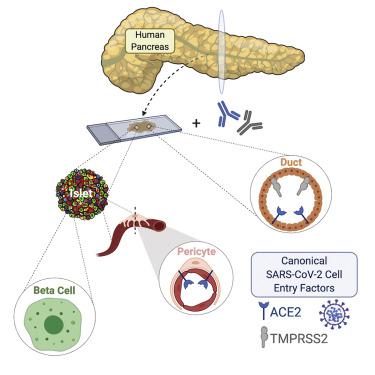Cell Metabolism ( IF 27.7 ) Pub Date : 2020-11-13 , DOI: 10.1016/j.cmet.2020.11.006 Katie C Coate 1 , Jeeyeon Cha 1 , Shristi Shrestha 1 , Wenliang Wang 2 , Luciana Mateus Gonçalves 3 , Joana Almaça 3 , Meghan E Kapp 4 , Maria Fasolino 2 , Ashleigh Morgan 2 , Chunhua Dai 1 , Diane C Saunders 1 , Rita Bottino 5 , Radhika Aramandla 1 , Regina Jenkins 1 , Roland Stein 6 , Klaus H Kaestner 2 , Golnaz Vahedi 2 , 7 , Marcela Brissova 1 , Alvin C Powers 8

|
Isolated reports of new-onset diabetes in individuals with COVID-19 have led to the hypothesis that SARS-CoV-2 is directly cytotoxic to pancreatic islet β cells. This would require binding and entry of SARS-CoV-2 into β cells via co-expression of its canonical cell entry factors, angiotensin-converting enzyme 2 (ACE2) and transmembrane serine protease 2 (TMPRSS2); however, their expression in human pancreas has not been clearly defined. We analyzed six transcriptional datasets of primary human islet cells and found that ACE2 and TMPRSS2 were not co-expressed in single β cells. In pancreatic sections, ACE2 and TMPRSS2 protein was not detected in β cells from donors with and without diabetes. Instead, ACE2 protein was expressed in islet and exocrine tissue microvasculature and in a subset of pancreatic ducts, whereas TMPRSS2 protein was restricted to ductal cells. These findings reduce the likelihood that SARS-CoV-2 directly infects β cells in vivo through ACE2 and TMPRSS2.









































 京公网安备 11010802027423号
京公网安备 11010802027423号